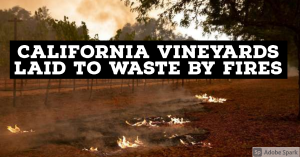Amid the horrible California wildfires, one of the trends that I warned about that needs to be watched is the prices of alcohol, especially wine and some brandies, since the fires are destroying the vineyards used by many American wineries. This will likely cause a spike in wine prices, and depending on the scope of the fires, possibly a large one.
Unfortunately, it appears this trend is coming true, as BloombergQuint reports that in the Napa Valley, one of the most critical grape-growing regions, 80% of Cabernet Sauvignon grapes have been lost.
What began on the morning of Sept. 27 as a 20-acre brushfire in Napa’s eastern hills has now become a fast-growing conflagration covering more than 65,580 acres in Napa and Sonoma counties, as of Monday morning, according to Cal Fire. A reported 826 structures have been destroyed and an additional 163 damaged. On Sunday morning, the City of Calistoga reported that in Napa County, at least 264 commercial properties and 173 homes have been lost, with an additional 57 damaged. Cal Fire expects those numbers to rise. So far, no deaths have been reported.
The fires are from the northern part of the valley, from Calistoga to just south of St. Helena, and on the east and west hillsides. They’ve expanded from Howell Mountain, Diamond Mountain, and Spring Mountain well into Sonoma. The fire now threatens areas on both sides of the valley south of St. Helena, including Rutherford, home to Inglenook, owned by film director Francis Ford Coppola.
The list of destroyed or damaged wineries this week grew longer. In addition to those on Spring Mountain, it includes boutique winery Château Boswell and historic Burgess Cellars on Howell Mountain, purchased just weeks ago by billionaire Gaylon Lawrence, owner of Napa icon Heitz Cellar. Treasury Wine Estates, which owns Sterling Vineyards, issued a statement that buildings were damaged, though details were scant.
Flames also engulfed beloved resorts that were already having a hard year because of Covid-19. Calistoga Ranch, part of Auberge Resorts, is mostly gone. At Meadowood, where the Napa Valley auction has been held since 1981, the restaurant and its three Michelin stars are a pile of ash and rubble.
Philippe Melka, a winemaking consultant to three dozen high-profile wineries that include Newton, typically makes about 2,000 cases. This year, he won’t make any. “Smoke is moving around,” he says.
The chemical compounds in smoke can get into the skin of grapes exposed to it for a period of time, making the resulting wine smell and taste like a wet ashtray. Smoke from the Glass Fire is adding to that of fires last month.
Melka estimates that 80% of vineyards may be affected. Those in the south of Napa, from sub-regions such as Pritchard Hill, Stags Leap, and Mount Veeder may be all right. “But in a year like this,” he says, “who will pay $300 for any wines?”About 51% of Napa’s grapes are cabernet, and the expensive wines made from them generate much more revenue than, say, sauvignon blanc. The Napa wine industry contributes roughly $34 billion in revenue to the U.S. economy, and a lot of that comes from cabernet. But Melka doubts that there will be many premium cabernets from elite Napa labels in 2020.
Wines made from white grapes picked before any fires struck will probably be fine. On Diamond Mountain, sparkling wine producer Schramsberg, whose wines have been poured at White House state dinners, were still beating back active fires, but all the chardonnay and pinot noir grapes for the house’s 2020 bubblies have been picked and processed and stashed safely in historic caves. (source)
If you love wine, it is probably a decent idea to buy some now, especially since prices are likely going to increase for the rest of the year and into the net year as well, since it will take at least a year to rebuilt the damaged crops from the fires.



